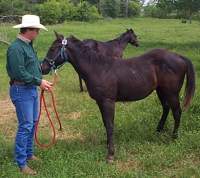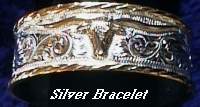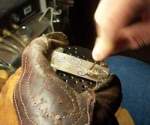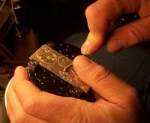 Friday, June 18, 1999, Minnewaukan, North Dakota -
These hands belong to metal. They have worked for years hammering iron shoes to the hoofs of giant animals. They calmed horses and fashioned new shoes for them. These hands belong to a farrier - a horseshoer. They belong to a man who loved working with the animals, and he loved working with the owners and with the tools and the metal, so when his back gave out, and it would no longer support him against the powerful animals, Darryl Howard sat down and put his head in his hands.
Friday, June 18, 1999, Minnewaukan, North Dakota -
These hands belong to metal. They have worked for years hammering iron shoes to the hoofs of giant animals. They calmed horses and fashioned new shoes for them. These hands belong to a farrier - a horseshoer. They belong to a man who loved working with the animals, and he loved working with the owners and with the tools and the metal, so when his back gave out, and it would no longer support him against the powerful animals, Darryl Howard sat down and put his head in his hands.
 He sought a new way to earn a living, and he sought a new way to work with metals and with his hands. He tried making spurs for a while (he has a collection of over 1,000 bits) but he just couldn't enter that narrow market. Two friends; Boyd and Harlan Ingman, made silver and copper jewelry, including bracelets, earrings and rodeo prize belt buckles, and they invited Howard to take up the trade.
He sought a new way to earn a living, and he sought a new way to work with metals and with his hands. He tried making spurs for a while (he has a collection of over 1,000 bits) but he just couldn't enter that narrow market. Two friends; Boyd and Harlan Ingman, made silver and copper jewelry, including bracelets, earrings and rodeo prize belt buckles, and they invited Howard to take up the trade.
In a dark corner of the basement in his home, which is close enough to Devil's Lake to flood, lately, Howard spends most of his days soldering, engraving and polishing copper, German silver (mostly nickel) and brass. It is a more sedentary and lonely job than traveling central North Dakota, visiting horse owners and shoeing their horses, and he misses the action. "I sure like silversmithing," he says. "But I miss the physical labor of being a horseshoer - I never felt better as when I had grease running off my nose."
 To make a belt buckle, Howard starts with a piece of 18 gauge German silver, about three, by four inches. He uses silver solder to fasten a braid around the metal, then to apply one or more cast-metal logos of animals, or other western icons. Sometimes he will custom make logos of letters or brands, but mostly he buys them from a small foundry in Littleton, Colorado.
To make a belt buckle, Howard starts with a piece of 18 gauge German silver, about three, by four inches. He uses silver solder to fasten a braid around the metal, then to apply one or more cast-metal logos of animals, or other western icons. Sometimes he will custom make logos of letters or brands, but mostly he buys them from a small foundry in Littleton, Colorado.
Howard then curves the buckle, to give it proper form around the waist, using a hydraulic press. Before he owned the press, he did this by placing the buckle inside an Army helmet and pounding it with a cannonball. "It worked well, but it was Hell on the body," he says.
Then he solders the buckle-back (the hardware which will attach to the leather belt) and the hook. "At that point," Howard says, "the buckle is pretty ugly." Its looks will improve greatly after a few hours in the vise. Howard clamps the buckle in a swiveling vise and begins the more creative process of his work.
 Hunched over the vise, Howard focuses intently on his subject. With a heavy, leather glove protecting his left hand, he uses a small chisel in his right. He carves out the edges of leaves, using a "wriggle" stroke, so named because he gently rotates his hand - and the chisel - along the metal. This creates an outline of paisley designs. He then uses a pneumatic graver to carve leaves inside, in a process called "western bright cutting." He uses a narrower graver, called a "liner" to give the artwork shading. He will cover the entire buckle with either engravings, logos, braids or stones (usually turquoise.) Howard finishes the buckle by polishing it on a high-speed wheel.
Hunched over the vise, Howard focuses intently on his subject. With a heavy, leather glove protecting his left hand, he uses a small chisel in his right. He carves out the edges of leaves, using a "wriggle" stroke, so named because he gently rotates his hand - and the chisel - along the metal. This creates an outline of paisley designs. He then uses a pneumatic graver to carve leaves inside, in a process called "western bright cutting." He uses a narrower graver, called a "liner" to give the artwork shading. He will cover the entire buckle with either engravings, logos, braids or stones (usually turquoise.) Howard finishes the buckle by polishing it on a high-speed wheel.
Howard trains formally when he can, and he attended a seminar in Kansas last year to improve his skills. Like any craftsman and artist, he will make a mistake from time to time - a slip of the chisel, a mistaken stroke - but he has always been able to repair his work. He has always respected and cared for tools, but now more than ever. "The degree of the sharpness of your tools is instrumental to the quality of your work," he says.
 Howard works with copper and brass, but mostly with German silver, which is considerably cheaper than sterling silver. It also looks beautiful, and is just as durable, but it is not real silver. Though he is beginning to use sterling in his work, the material puts him into a steeper market. The successful silversmiths with a strong following use only sterling silver.
Howard works with copper and brass, but mostly with German silver, which is considerably cheaper than sterling silver. It also looks beautiful, and is just as durable, but it is not real silver. Though he is beginning to use sterling in his work, the material puts him into a steeper market. The successful silversmiths with a strong following use only sterling silver.
One of the downsides to such success, would be that his work would become unavailable to the people he respects most; the people like him and his wife, Marcie. "You lose touch with people like us - we're as common as you can find," he says. Howard could have copies of his work made, which would sell for far less, but he would regret that his customers would not get hand tooled works of his art. When he worked with horses, he placed every shoe on every horse by hand, and he feels right about making jewelry that way.
There is a lot of craft to his work, as there was in horse shoeing, but there is also the art, which is the frightening part. Where once he would shoe a horse - and there was a right way and a wrong way, and he would do it the right way and earn his pay - there are millions of ways to make a belt buckle, and only so many of them are his ways. He puts his heart and his creative energy into every piece he makes, and into it, he nearly carves a part of himself, He then offers it to strangers and lays his pride on the table. Many will say his work is beautiful, but will they pay to own it? How much will they pay? Right now, where he is in his art form, people will pay for German silver. But he knows, that with practice, his skills will develop, his talents will mature, his reputation will grow, and he will graduate to using only sterling. Until then, he continues on his second career, in his basement workshop, creating belt buckles, bracelets and other jewelry prodigiously, like a Van Gogh, trading paintings for empty canvases.





